Key Takeaways
- A recent survey found that 60 percent of foreign-language students and nearly 14 percent of instructors reportedly use smartphones for language-learning purposes.
- However, neither students nor teachers are fully realizing the educational potential of mobile devices.
- Students need guidance on where to find resources beyond the standard dictionary and translation apps and on how to leverage those resources for language learning.
- Instructors must closely collaborate with faculty, IT experts, and educational technologists to take full advantage of the educational potential of mobile devices.
Increasingly, mainstream mobile technologies are finding their way into students' lives and thus into the classroom. One way of dealing with these potentially distracting elements is to ban them altogether. Another approach is to find ways to put mobile devices at the service of learning — an area where students are in dire need of assistance.
As we can see every day on our college campuses, mobile devices have become an integral part of students' lives, putting truly authentic and engaging cultural materials at their fingertips. Because these mobile devices offer many tools for formal or informal language learning, we sought to discover whether or not students and instructors use these resources — and, if they do, what kinds of tools they use and for what purposes. We also wanted to see whether students had any recommendations on how instructors could incorporate mobile learning resources into the curriculum.
Survey Findings
To answer these questions, the University of Colorado at Boulder's Anderson Language & Technology Center (ALTEC) collected data through a web-based questionnaire taken at random by language-student patrons of the ALTEC multimedia library. A total of 80 students answered the survey. Of those 80 students, 58.3 percent were enrolled in French language classes, 17.7 percent in Spanish, 10.1 percent in German, and 13.9 percent were either studying other languages or enrolled in more than one language course. As Figure 1 shows, 97.5 percent of the students surveyed reported owning a cell phone (regular or smart), with 69.6 percent owning a smartphone specifically. For contrast, a similar survey was sent out to the university's language instructors, faculty, and TAs. Of that survey's 38 respondents, 89.5 percent reported owning a cell phone, and 31.6 percent reported owning a smartphone.
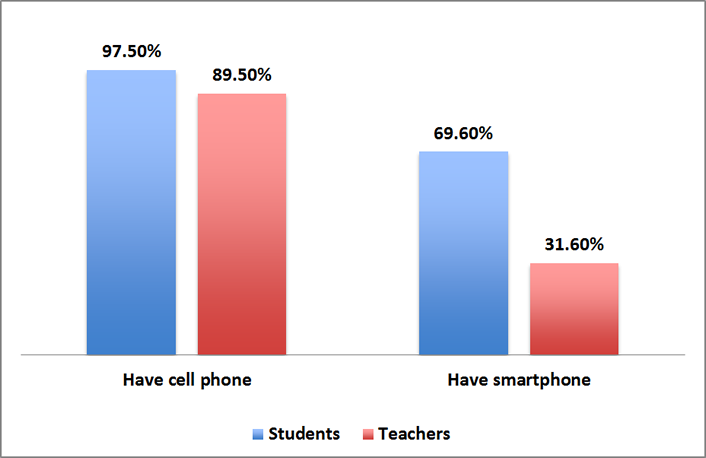
Figure 1. Percentage of Students and Teachers Owning Cell Phones and Smartphones
Student and Teacher Use of Mobile Devices
According to the survey, 60 percent of the students and 13.9 percent of teachers use their smartphones for language-learning purposes.
As Figure 2 shows, when we asked students what types of applications they use for language learning, the two most popular reported were dictionary apps (45.2 percent) and translation apps (32.9 percent). Interestingly, only 5.5 percent of the respondents reported using their smartphones to access authentic resources, such as radio programs or newspapers, in the target language.
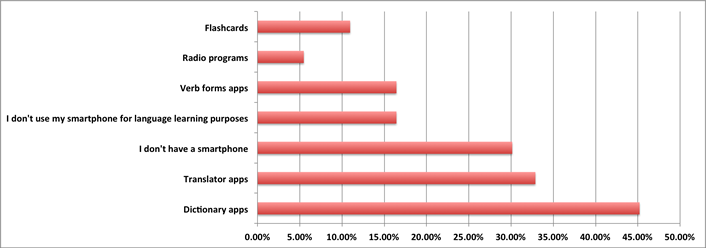
Figure 2. How Students Use Smartphones for Language Learning
We also asked teachers how they use their mobile devices for language instruction. Among the few answers collected, teachers mentioned using dictionary apps and using their devices (mostly iPads) for purposes such as PowerPoint presentations, playing YouTube clips, presenting statistics, and so on. Several, however, expressed an interest in hearing further ideas and suggestions on how to use mobile devices in the language classroom; this indicates that, while willing to try, many teachers are still unsure about how to proceed.
Student Reactions and Comments
In the last part of the survey, we asked students to share their opinions about the use of smartphones in the classroom and to make suggestions to their instructors on how to leverage the educational potential of smartphones both inside and outside of the language classroom.
"Not all students have a smartphone"
Several students were concerned about instructors' use of smartphones for language learning due to perceived economic discrimination. One student warned against incorporating smartphone activities in the classroom because "It's not really fair to people who don't have smartphones that those who are more financially well [off] and care to have a smartphone get an advantage." Although a valid point, this should not preclude instructors from using smartphones in the classroom. In our case, more than two-thirds of students own smartphones, so they can easily share the mobile devices in the classroom in paired activities, thus bringing Internet capabilities to the non-smart classroom through a portable device.
"Data doesn't come free"
Another financial concern that student respondents raised was prohibitive data pricing. As one of them noted, "Data doesn't come free." To address this issue, teachers can encourage students who use smartphones in class to connect to the university wireless network. Alternatively, instructors can limit in-class use of applications that require high bandwidth, such as video-centered apps. Another way to address the data-fees issue is for instructors to favor the use of freestanding apps that do not require an Internet connection for use. In any case, instructors should always remind students that the great majority of smartphone applications can also be accessed from any computer connected to the Internet. Establishing this connection between smartphone apps and Internet sites can alleviate the pressure on students who don't own smartphones.
"I don't think smartphones are viable teaching tools"
A few of the students surveyed appeared to be strongly opposed to the use of smartphones in the classroom because they were skeptical about their educational value: "With their current capabilities, I don't think smartphones are viable teaching tools." Several students reported not knowing where to find free or affordable language-learning resources. These findings suggest that students need guidance on how to use their mobile devices for education, as well as suggestions for free apps that can be leveraged for language learning. As a result of the concern about educational pricing, the ALTEC compiled a list of free or affordable mobile resources that we have shared with language instructors, posted in our media library, and uploaded to our website. (See "Featured Applications" for a brief description of several such resources.)
Responses in the comments section of the student survey varied greatly:
- Students asked for recommendations for flashcard, "word of the day," and conjugation-practice apps, as well as for podcasts offering formal grammar instruction.
- Some students suggested that instructors encourage students to change their phone settings into the target language; another liked the idea of students texting among themselves in the target language.
Students also recommended that instructors use a mobile-compatible learning management system (LMS) so students could check their homework assignments and read course announcements from their mobile devices. Today, major LMS companies (such as Blackboard, Moodle, and D2L) do indeed offer mobile components, but many students are unaware of this.
Featured Applications
VoiceThread: The app for this free online program lets users create a digital slideshow using an iPhone or iPad — recording text, audio, or webcam comments — and then share the slideshow with others for commenting.

Stitcher Radio: Stitcher Radio plays more than 5,000 radio shows and podcasts on demand, free. The search capabilities let users easily conduct searches according to theme or language and create bookmark lists of their favorite programs.
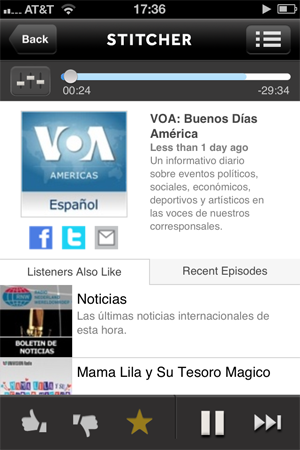
Wizee Shopping: Wizee provides mobile assistance to shoppers in Saint Petersburg and Moscow. This free app lets users access mall maps, movie schedules, and sale information, and even view fashion "look books" in Russian.
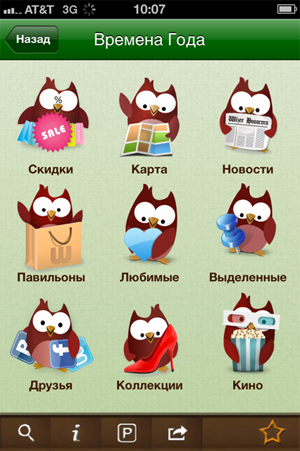
Iberia: The app for the Spanish airline Iberia provides the schedules, arrival and departure information, and auto check-in for flights, all in Spanish. The information is contextual, authentic, and easy to navigate.
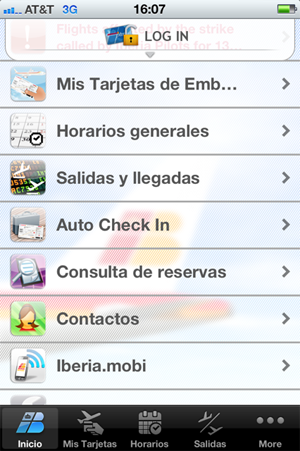
Teacher Reactions and Comments
Of the 38 teachers who responded to the survey, 15 offered input on ways to incorporate mobile devices in the language classroom.
- The most frequent comment focused on the need for guidance and training on how to leverage the potential of mobile devices: "I have not yet given this much thought, but I am certain that we can use the technology to our students' benefit. I would love to be involved in working with others to come up with innovative ideas."
- Only a few teachers expressed resistance to or skepticism about introducing such devices in the classroom.
- Some teachers offered concrete recommendations for language classroom activities using mobile devices; most of these practices were presentation-oriented.
Using Smartphones in (and Beyond) Foreign Language Classrooms
Based on this survey, it appears that both students and teachers are not yet making optimal use of the educational potential of their mobile devices. Students need guidance on where to find apps and how to best leverage them for language learning. Several students requested flashcard apps, for example, thus exhibiting the pattern of wanting to port physical learning practices to web devices. Similarly, most teachers' recommendations were geared toward teacher-centered uses of mobile devices — such as using them to project PowerPoint slides, images, or videos on a screen. We believe, however, that the best way to exploit the potential of mobile devices or any other technology is to capitalize on their unique educational abilities to actually enhance existing practices or create novel learning experiences.
Suggestions for In-Class Activities
To create a classroom environment that both welcomes the smartphone and accommodates the non-smartphone user, we recommend doing mobile-device activities in pairs or in small groups in which a team captain primarily operates the phone. In-class activities for smartphones range from manipulating phone settings to downloading and using specific apps. For example, language instructors might ask students to use a mobile device to:
- Generate shopping or to-do lists and then share them with other groups
- Discuss weather forecasts using target vocabulary and alternate temperature measurement systems
- Practice telling time with the 24-hour clock
- Search and discuss recipes and then write their own recipe and share it with other students
- Use authentic urban transportation maps for buses, trains, or metros to give directions and organize trips to international destinations
- Locate restaurants within a certain perimeter and then discuss price, menu, and transportation options
- Read and share interesting newspaper articles
- Watch movie trailers, check show times in various theaters, and cross-reference the information collected against local maps
- Browse the course offerings at international universities and plan their class schedule for a semester abroad
Visiting our list of useful language learning apps can help instructors incorporate these types of activities into the language curriculum. Our list includes apps for voice recording, video chatting, text manipulation, listening, general practice, event recording, and travel, as well as language-specific apps for Arabic, Chinese, ESL, French, German, Hebrew, Hindi, Italian, Japanese, Korean, Portuguese, Russian, and Spanish.
Suggestions for Out-of-Class Activities
Many out-of-class activities can be done using either a smartphone or a personal computer, with the intent being to share with students the language-learning possibilities that mobile devices afford. Instructors could encourage students to use their mobile devices to subscribe to news programs and podcasts of personal interest, and then give them an opportunity to share particularly relevant topics in class. Students also could be encouraged to alter the format and purpose of texting or posting on social network sites so that they use the target language in these everyday activities and share the posts with classmates.
Applications like VoiceThread let students create digital media slideshows by recording text, audio, or webcam comments and then sharing the slideshow with others for commenting. Similarly, students who do not own a smartphone can use the VoiceThread website to upload photos or other media taken using conventional cameras for the activity. One instructor at CU Boulder also reported organizing scavenger hunts "where one person per group uses a smartphone to gather clues from the blog while navigating around campus." VoiceThread would be a practical app for this type of student-centered activity because it is free, easy to use, has multiple sharing features, and offers a website component.
Conclusion and Recommendations
As our findings indicate, both students and instructors need help leveraging the educational potential of mobile devices, whether for language learning or any other subject. Addressing this need requires the close collaboration of faculty, IT experts, and educational technologists.
The following recommendations offer some ideas on how to begin to address this need at the campus level:
- Collaborate with subject matter experts to compile and maintain lists of useful applications and share them with students and faculty. The list we compiled is available here; we welcome feedback to further improve this collection.
- Organize workshops, roundtables, and demonstrations on educational uses of mobile learning resources.
- Identify best practices and share them with the campus community in the form of lesson plans, video clips, or demonstrations.
- Ask for students' input on the matter. As our survey indicates, there can be a fairly large discrepancy in mobile-device ownership between faculty members and students.
Undoubtedly, students will continue to bring their mobile devices to the classroom; the question that we face is whether these devices will enhance or detract from the learning processes. Although proficient in using mobile technologies for entertainment purposes, students are not necessarily familiar with how to use these tools for educational purposes. Now is a crucial time for educators and students to come together and establish guidelines on appropriate, responsible, and engaging uses of mobile devices.
Edwige Simon and Courtney Fell are Language Technology Specialists at the Anderson Language & Technology Center at the University of Colorado at Boulder.
© 2012 Edwige Simon and Courtney Fell. The text of this article is licensed under the Creative Commons Attribution-NonCommercial-NoDerivs 3.0 Unported License.
